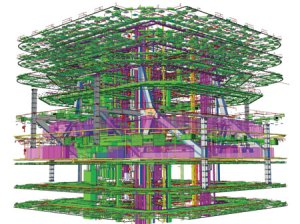 BIM (Building Information Modeling) is a process involving the generation and management of digital representations of physical and functional characteristics of places, as defined by Wikipedia.
BIM (Building Information Modeling) is a process involving the generation and management of digital representations of physical and functional characteristics of places, as defined by Wikipedia.
Why should an occupier of office space care about BIM? Reducing operating costs is paramount for any business, and the real estate piece of the pie is no small slice. If a business owns their own building, they must take full responsibility for such costs. However, business’s often lease space assuming that the responsibility of reducing their buildings operating costs is the landlord’s problem. Conversely, any tenant leasing space for a long period of time can have a profound effect on reducing the operating costs of a building. This fact is more important in a large headquarters lease that is Triple Net (NNN) in nature, but is also important in a longer term full service lease where the tenant will pay for increases in operating expenses above the base year.
 Other than managing those expenses through a well negotiated lease and reviewing the operating expenses annually, the tenant can further affect the outcomes of a building performance through Building Information Modeling (BIM). How does BIM reduce operations and maintenance costs? BIM provides an intuitive way to access accurate information quickly. A recently published article by Andrew Arnold in DPR Review speaks to BIM savings and puts it into the perspective of initial cost, “A building’s design and construction cost is only 10 percent of the cost over the life of a building.” “Dr. Paul Teicholz, professor emeritus at Stanford University and founding director of the Center for Integrated Facility Engineering (CIFE), estimates that the value of integrated information flow from BIM to operations for a 400,000-sq.-ft. office building is 10 cents per square foot annually, with less than a two-year return on investment. That may be even higher for a facility like a hospital.”
Other than managing those expenses through a well negotiated lease and reviewing the operating expenses annually, the tenant can further affect the outcomes of a building performance through Building Information Modeling (BIM). How does BIM reduce operations and maintenance costs? BIM provides an intuitive way to access accurate information quickly. A recently published article by Andrew Arnold in DPR Review speaks to BIM savings and puts it into the perspective of initial cost, “A building’s design and construction cost is only 10 percent of the cost over the life of a building.” “Dr. Paul Teicholz, professor emeritus at Stanford University and founding director of the Center for Integrated Facility Engineering (CIFE), estimates that the value of integrated information flow from BIM to operations for a 400,000-sq.-ft. office building is 10 cents per square foot annually, with less than a two-year return on investment. That may be even higher for a facility like a hospital.”
 Building performance is crucial in todays environment. High-quality work environments makes it easier to recruit and retain talented people. Engaging the owner’s operations and management teams early in design process ensures that the data they need to run the building more effectively is baked into the model from the very beginning.
Building performance is crucial in todays environment. High-quality work environments makes it easier to recruit and retain talented people. Engaging the owner’s operations and management teams early in design process ensures that the data they need to run the building more effectively is baked into the model from the very beginning.
In a white paper “Getting the Most Out of BIM: The Secret Guide to VDC Apps,” DPR’s Andrew Fisher further addresses BIM and addresses virtual design and construction (VDC), along with an array of new software applications that are being developed to meet that demand.
Andrew points out the top BIM tools: “For coordination, Autodesk Navisworks Manage stands out for its clash detection capabilities, while Autodesk BIM 360 Glue is also gaining popularity. Tapping into the power of the “cloud” to access the model, BIM 360 Glue works with iPads in the field.
For other BIM functions, some of the top applications include Lumion 3D for visualization, Solibri Model Checker for analysis and measurement, Synchro for sequencing, and Vico for estimating, to name just a few.
Understanding how to select and fully utilize the best BIM tools to their potential can create the most direct benefits to a project team’s processes, productivity and overall performance on a job.”
